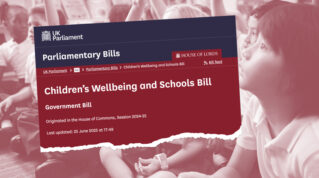Multi-academy trust performance data has been published for the first time in three years, despite school leaders warning that Covid has rendered it “inherently flawed”.
The MAT figures cover key stage four results from 2022, when secondary pupils sat external exams for the first time since before the pandemic.
The government recently said that public data was “important” for parents and students, but urged them to use it “cautiously” and ask schools for context given Covid’s uneven impact.
1. Scores on the doors
The progress 8 scores of MATs included in the league tables averaged -0.02. This is fractionally above the national average (-0.03), which also includes maintained schools and standalone academies.
The headline MAT figure is unchanged compared with 2019, the last available data.
It is important to point out that only results for trusts which have at least three schools that have been with the trust for at least three years are included.
2. Smaller trusts do best …
Forty-five per cent of MATs with fewer than 10 schools in the data posted progress 8 scores above average – against 35 per cent of trusts with at least 10 schools.
Ministers had wanted trusts to have at least 10 schools – or 7,500 pupils – by 2030 but have abandoned their ambitions.
However, any comparison becomes tricky because larger trusts are more likely to have sponsored academies (those that were taken on following ‘inadequate’ ratings, as opposed to ‘good’ or better schools that chose to convert).
Among bigger trusts, nearly three-quarters of the academies were sponsored, compared to just 40 per cent at smaller trusts.
3. …But the best big MATs win out
While fewer big trusts recorded above average progress scores, those that did so performed significantly better.
Only six of 17 larger MATs in the tables surpassed the national average, but did so by almost a third of a grade (0.31), compared to 0.23 among the smaller MATs. This is also despite them having a larger number of sponsored academies, with some well-known turnaround trusts.
Harris Federation had the highest results among them (0.39), followed by United Learning (0.35), Star Academies (0.33), Delta Academies Trust (0.3), Ark Schools (0.25) and Northern Education Trust (0.09).
Their success meant the average large MAT’s progress 8 score was 0, whereas MATs with fewer than 10 schools recorded -0.03.
4. Top trusts full of converter schools
Twyford Church of England Academies Trust topped the tables, with a 0.93 progress 8 score. The Gorse Academies Trust ranked second (0.72) and Girls’ Learning Trust third (0.69).
Eight MATs scored 0.5 or more – deemed “well above average” by the government, up from six in 2019. Five of the eight had no sponsored academies, however.
Fifteen of 193 MATs included saw progress 8 scores below -0.5. Tyne Coast Academy Trust saw the lowest scores, with progress one grade below average.
Annual accounts highlight Covid’s “significant impact” and “extreme deprivation” at one school. Another is a university technical college, which the government includes in the data despite acknowledging that progress 8 is “not the most appropriate” for them.
5. New accountability metrics
For the first time, 2022 data includes how MATs fare across attainment 8 and ‘strong passes’ at grade 5 or above in English and maths.
The average MAT saw 47.8 per cent of pupils secure ‘strong passes’, with larger trusts’ scores slightly lower (46.1 per cent) and smaller MATs slightly higher (48.4 per cent). Both were below the all-school average (49.8 per cent).
On attainment 8, MAT scores averaged 48.3, also slightly below the all-school average (48.8).
Girls’ Learning Trust, a three-school London MAT, was the highest-performing MAT on both measures. It has a below-average number of disadvantaged pupils, though they perform significantly above average.
6. But experts urge caution
Steve Rollett, deputy chief executive of the Confederation of School Trusts, said the figures were “useful”, but do not “fully reflect local circumstances, including the differential impact of Covid”.
He welcomed the DfE data website’s rebrand as a tool to “check”, not “compare”, performance.
Tiffnie Harris, data specialist at ASCL, said the school leaders’ union had repeatedly urged the government not to publish the data to prevent “invidious” comparisons, dubbing it “inherently flawed”.
ASCL wants a longer-term overhaul of “unclear, unfair and narrow” metrics, including wider measures.
















Your thoughts